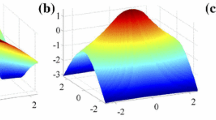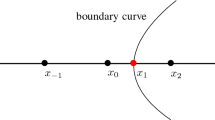Abstract
This paper presents a new approach to reinitialization in finite element methods for the level set transport equation. The proposed variational formulation is derived by solving a minimization problem. A penalty term is introduced to preserve the shape of the free interface in the process of redistancing. In contrast to hyperbolic PDE reinitialization, the resulting boundary value problem is elliptic and can be solved using a simple fixed-point iteration method. The minimization-based approach makes it possible to define the desired geometric properties in terms of a suitable potential function. In particular, truncated distance functions can be generated using a double-well potential. The results of a numerical study indicate that the new methodology is a promising alternative to conventional reinitialization techniques.






Similar content being viewed by others
References
Ausas RF, Dari EA, Buscaglia GC (2008) A geometric mass-preserving redistancing scheme for the level set function. Int J Numer Methods Fluids 65:989–1010
Basting S, Weismann M (2012) A hybrid level set—front tracking finite element approach for fluid–structure interaction and two-phase flow applications. J Comput Phys (submitted)
Elias RN, Martins MAD, Coutinho ALGA (2007) Simple finite element-based computation of distance functions in unstructured grids. Int J Numer Methods Eng 72:1095–1110
Hysing S, Turek S (2005) The Eikonal equation: numerical efficiency vs. algorithmic complexity on quadrilateral grids. In: Proceedings of Algoritmy, pp 22–31
Li C, Xu C, Gui C, Fox MD (2010) Distance regularized level set evolution and its application to image segmentation. IEEE Transact Image Process 19:3243–3254
Osher S, Fedkiw R (2003) Level set methods and dynamic implicit surfaces. Springer, New York
Parolini N (2004) Computational fluid dynamics for naval engineering problems. PhD thesis, EPFL Lausanne
Sethian JA (1996) A fast marching level set method for monotonically advancing fronts. Proc Natl Acad Sci USA 93(4):1591–1595
Sethian JA (1999) Level set methods and fast marching methods: evolving interfaces in computational geometry, fluid mechanics, computer vision, and materials science. Cambridge University Press, London
Sethian JA, Smereka P (2003) Level set methods for fluid interfaces. Annu Rev Fluid Mech 35:341–372
Smolianski A (2001) Numerical modeling of two-fluid interfacial flows. PhD thesis, University of Jyväskylä
Sussman M, Smereka P, Osher S (1994) A level set approach for computing solutions to incompressible two-phase flow. J Comput Phys 114:146–159
Tsai YR, Cheng L-T, Osher S, Zhao H-K (2003) Fast sweeping algorithms for a class of Hamilton-Jacobi equations. SIAM J Numer Anal 41(2):673–694
Author information
Authors and Affiliations
Corresponding author
Additional information
This research was supported by the National Science Foundation under Grant #1015002.
Rights and permissions
About this article
Cite this article
Basting, C., Kuzmin, D. A minimization-based finite element formulation for interface-preserving level set reinitialization. Computing 95 (Suppl 1), 13–25 (2013). https://doi.org/10.1007/s00607-012-0259-z
Received:
Accepted:
Published:
Issue Date:
DOI: https://doi.org/10.1007/s00607-012-0259-z
Keywords
- Level set evolution
- Reinitialization
- Minimization problem
- Penalty method
- Variational formulation
- Finite element methods




